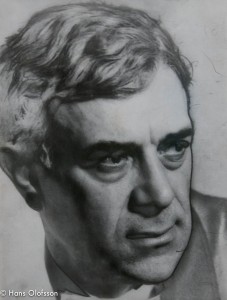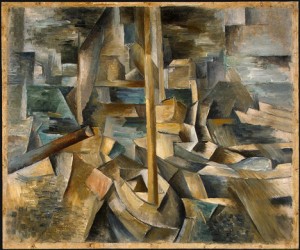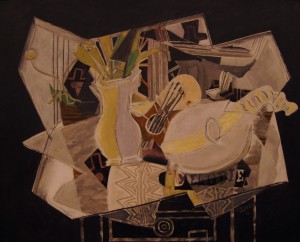
Georges Braque (photo Man Ray)
by Hans Olofsson, used under CC0
Georges Braque was born in Argenteuil, France on May 13, 1882. He later went on to create the art form of Cubism with Pablo Picasso. This was not the only style he used in his work though, other styles include impressionism, Fauvism and the making of collages. He also did stage designs for the Ballet Russes. Similar to Picasso, Georges went through phases in his work that went from portraying more sad subjects while other times it was more happy and lighter. Throughout his life, Georges Braque always came back to Cubism and it shows throughout all his work. After a fulfilled life, Georges passed away on August 31, 1963, in Paris.
Having been raised by a house painter, Georges at a young age planned to do the same since both his father and grandfather had done so but that would change when Braque began studying at the Ecole des Beaux-Arts. This love for painting that grew within Braque led to him moving to Paris where he became an apprentice of a master decorator.
During his early time as an artist, Georges used an impressionistic painting style that slowly changed into fauvist style after he researched the work of the Fauves. This art style incorporates bold colors and free-flowing structures that reflect emotions.
Braque made his first solo art show in 1908 at the Daniel-Henry Kawnweiler’s gallery. This show led to Braque to having much success and start working with Pablo Picasso as the worked to develop Cubism. Alongside Picasso, Braque revolutionized how painting was viewed and done at the time, making a style that wasn’t like anything of the time. Straying away from making a painting look as real as possible, cubism made it so it was abstract. It makes the viewer have to think and that is exactly what Georges Braque wanted his work to do to those viewing it. They also worked to incorporate collage elements into their work making the work that much more abstract.

Georges Braque – Harbor-1
by Karen Kohn, used under CC0
Similar to other artist of the period, Braque’s art style changed after the first World War, going from structured and planned out to less being unstructured and more spur of the moment. After an art exhibition of his in the Salon d’Automne in Paris, he garnered a lot of fame from his work which led to the famous dancer and choreographer Sergei Diaghilev to ask him to paint the decor for two of his upcoming ballets at the Ballets Russes.
Nearing the end of the 1920’s began a another style change for Braque as he steered towards painting realistic images of nature but there were still aspects of cubism that were present in his work. Another transition for him was starting to engrave plaster where his first major work took place only two years after first starting. It was his work at the Kunsthalle Basel that gained him international fame and won him a prize in 1937 at the Carnegie International in Pittsburgh.

2011-08-27 San Francisco 020 MOMA, Georges Braque – Vase, Palette et Mandoline
by Allie_Caulfield, used under CC0
The next World War brought another period of time that was reflected by more somber work. After it’s conclusion, Braque returned to scenes of nature and landscape. He also worked on lithographs, sculptures and stained-glass windows. Going into his elderly years, Braque’s health started to fail preventing him from doing any big projects. He would later die on August 31, 1963, in Paris.
For more information in regards to Georges Braque, feel free to click this link to other websites.
Georges Braque. (2014). The Biography.com website. Retrieved 01:25, Apr 14, 2014, from http://www.biography.com/people/georges-braque-9224611.
The Phillips Collection. (n.d.). Georges Braque and the Cubist Still Life, 1928–1945. Retrieved , from http://www.phillipscollection.org/events/2013-06-08-exhibition-braque
Caulfield, A. (Photographer). (2011, August 27). 2011-08-27 San Francisco 020 MOMA, Georges Braque – Vase, Palette et Mandoline [Web Photo]. Retrieved from https://www.flickr.com/
Kohn, K. (Photographer). (2011, November 1). Georges Braque – Harbor-1 [Print Photo]. Retrieved from https://www.flickr.com/
Olofsson, H. (Photographer). (2013, October 31). Georges Braque [Web Drawing]. Retrieved from https://www.flickr.com
